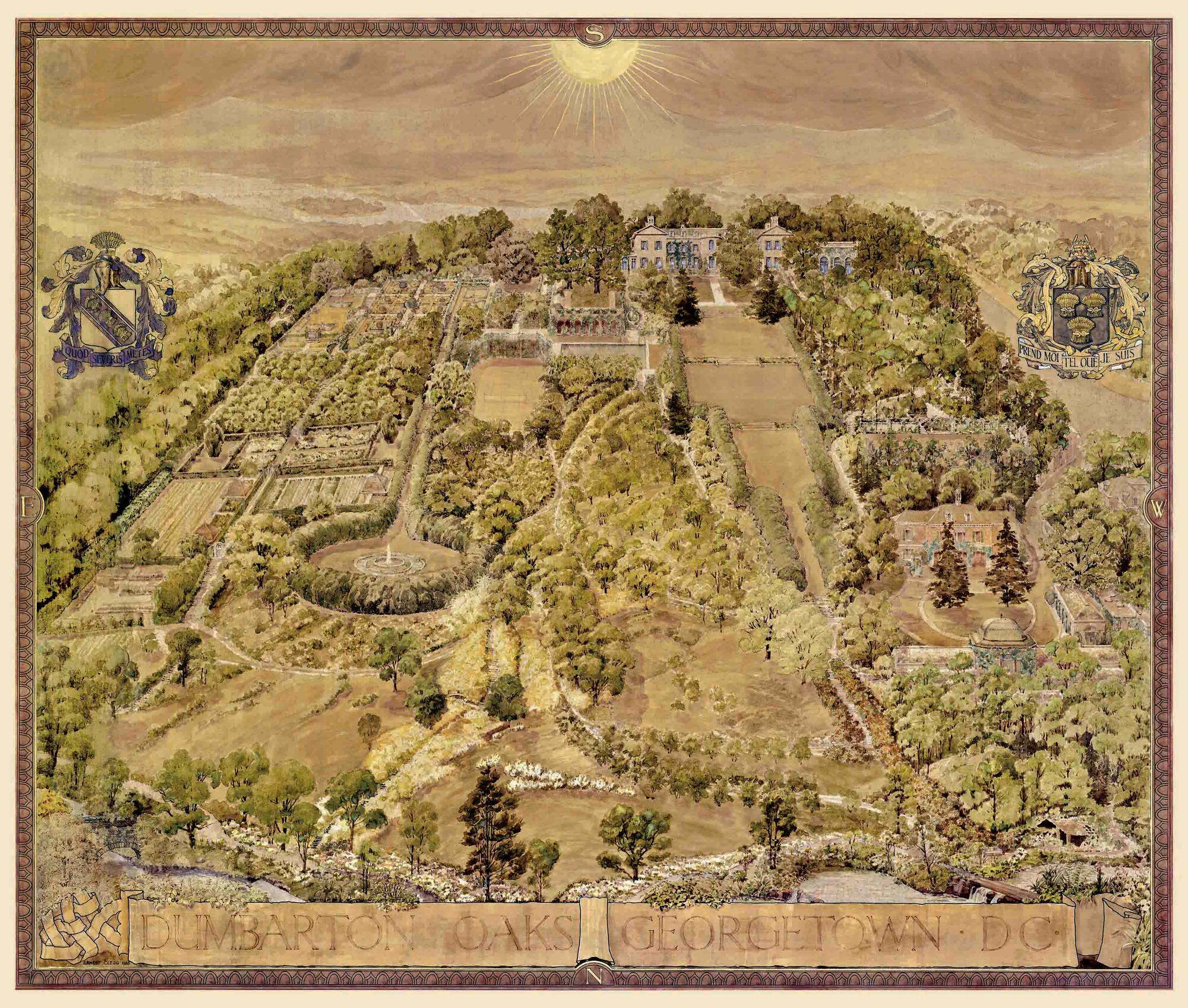
In summer of 1921, the landscape architect Beatrix Farrand met with the art collector and patron Mildred Bliss to discuss designing the landscape for the Blisses’ new residence, which they named Dumbarton Oaks, a stone’s throw from the nation’s capital. By June of 1922, Farrand offered Bliss a rich description of their joint vision for the garden.[1] Bliss replied with a note: “Your letter and its enclosures have made us purr with contentment.”[2] While walking and talking their way across the land, the two women discovered a shared aesthetic that would be realized over the next two decades as they constructed the new gardens and landscape. What began as a private residence and grounds would by the 1950s serve as a home of the humanities with extensive collections of books and art of the Byzantine and Pre-Columbian as well as Garden and Landscape Studies, under the leadership of Harvard University.
2021 marks the launch of our celebration of “A Century in the Gardens,” which explores the beauty and inspiration of Farrand’s design of the gardens and landscape. The Centennial is a critical moment to pause and appreciate as well as to re-assess the landscape and its legacy. It is a moment to look back as well as forward toward the next 100 years. Stewarding the Dumbarton Oaks gardens and landscape reminds us of the dynamic and often fragile nature of a work of art made up of living elements set in the outdoors, requiring creative and thoughtful stewardship by gardeners, stone masons, and museum curators, as well as by landscape historians and preservationists. It is a daunting task; thus, this centennial is also in part an occasion to recognize the concerted efforts of so many on behalf of this work of landscape art.

The centennial also offers the opportunity to re-conceptualize the garden and landscape not just as a work of art, but as an archive. Archives generally refer to valuable records, and are mostly thought of as documents and objects that offer evidence of past events, places, or people. The landscape as archive has been explored by scholars and artists, describing the land as a place where accumulated artifacts lie.[3] In a garden, we find the traces and inscriptions of design, construction, and planting. Gardens are both a historical archive and they offer the possibility of thinking of the archive as always changing, with the seasons and the years.
Dumbarton Oaks holds an extensive archive on the gardens, comprised of drawings, photographs, and correspondence as well as sales receipts and reports, much of which is available through HOLLIS, Harvard Library’s catalog. This collection includes the drawings produced during the landscape’s initial development and later stewardship, revealing design intentions as well as changes over the decades. However, more remarkable is that the garden itself is a part of the larger archive. The garden as a living archive engages in dialogue with the documents, verifying or countering what was actually built and how it matured over time, and suggests the significance of gardening as a form of labor and care. Finally, in addition to the archives as documents and as living reference, the landscape serves as ecological and horticultural archives. Gardens are living works of art and history.
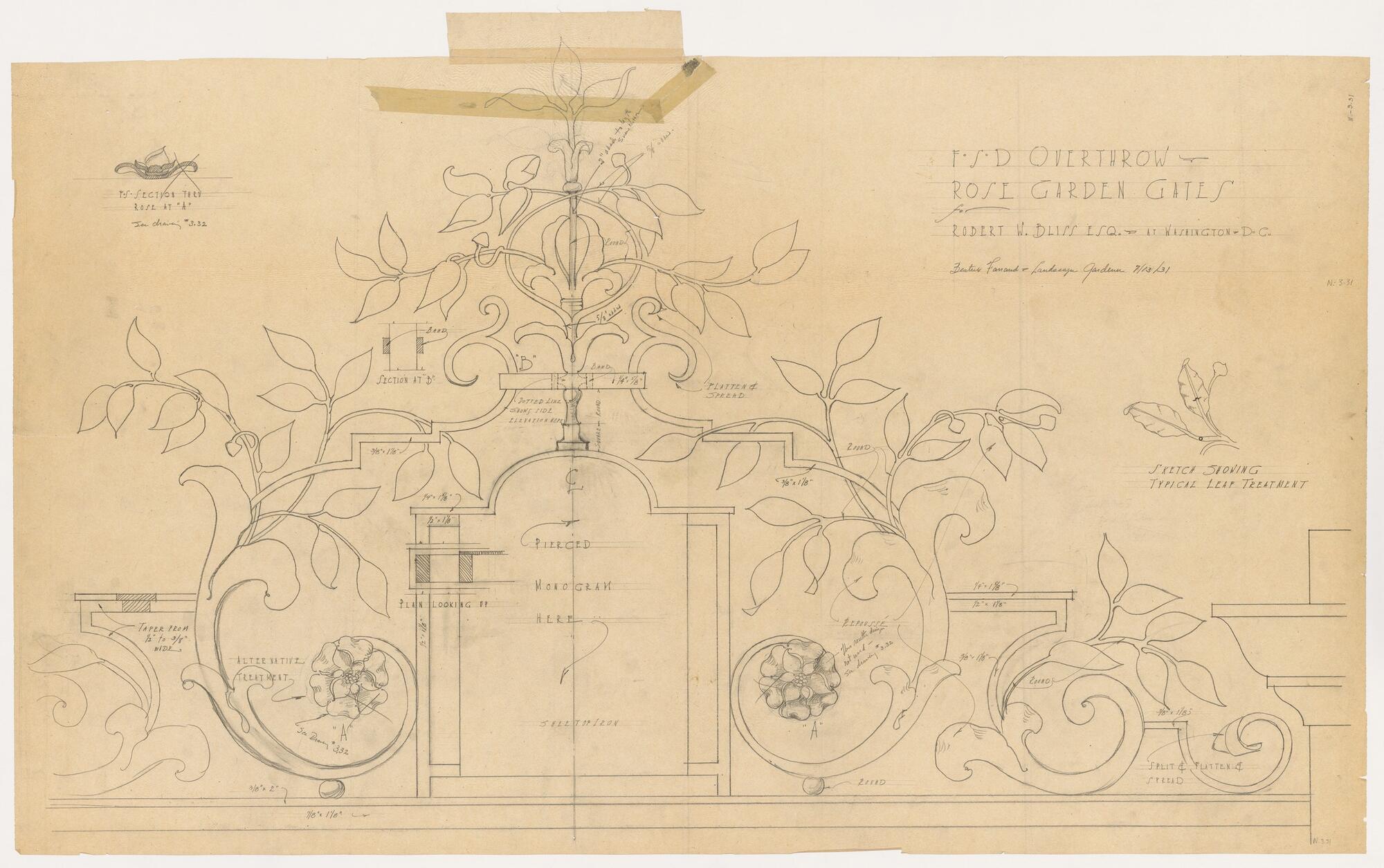
It is likely easiest to imagine the gardens of Dumbarton Oaks as a design archive, for it is in the inscription of Farrand’s design that we are made most aware as we walk along her paths, take in her framed views, and marvel at her compositions of plants, stone ornaments, and water fountains. This is a critical part of research, especially at Dumbarton Oaks: only in living Farrand’s design can we truly claim to understand her intentions. And every visitor to the garden shares this experience; the more one visits, the more one understands and knows the gardens.
The Garden Archives record over 1,226 drawings and sketches as well as a rich correspondence developed for the landscape and its garden rooms from 1922 to 1947. These records reveal that Farrand used both prose and drawings to communicate design to her clients and patrons. Further, she relied on her capacity to oversee in person the actual construction and planting of her designs so that she might alter and refine them in place. In a manner of speaking, Farrand’s toolbox of approaches included her facility with prose, whether in a long descriptive letter or a to-the-point telegram; drawings including sketches and vignettes as well as detailed plans, engineering drawings, and full-scale delineations; and her oversight on site during construction and over decades of stewardship. These three approaches—prose, drawing, onsite refinements—to representing and communicating the design process informed Farrand’s relationship with both her clients and the gardeners, and also shaped the designs as they developed into complex garden rooms in expansive landscapes.
Born in 1872, Beatrix Cadwalader Jones (later Farrand) grew up in an era when opportunities for women were expanding, with access to colleges and to careers including those in art, botany, and teaching, among others. Landscape architecture was one field attracting women, likely due to its emergence as a profession[4] at the same time as women were entering the workforce, but likely more importantly because it fit well with the education and training offered to women of the era. Dumbarton Oaks came to Farrand at the height of her career when Mildred Barnes and Robert Woods Bliss commissioned her to design the landscape and gardens for their new home in Washington, DC, on the outskirts of Georgetown.
Farrand began each project by walking with her clients through the landscape and then commissioning an official survey for the property. Her attention to topography is evident in her first drawings for the landscape, often overlaid on the contour lines. Farrand also produced engineering drawings of the Dumbarton Oaks landscape that detailed the cut and fill necessary to build the garden terraces along the steep slope. She carefully calculated the height and breadth of the retaining walls, as well as the dimensions of the stairs, to create the flat terrace that would feature the Rose Garden and to create an experience of a relaxed stroll down what was in fact a steep slope. Today we can walk the landscape to better understand how her drawings were implemented in place, and whether she was successful in creating the human experience that she sought.
Drawings were pertinent to Farrand’s interrogation of the human scale as it would be experienced in the garden in relationship to the structural armature necessary to create the garden rooms. Drawing vignettes of the garden rooms allowed Farrand to convey her intended character of each space, more evocatively than a plan or even prose. In a watercolor vignette for the stairs to the swimming pool, Farrand applied colors that differentiate the stone work from the plants. Her attention to media and color reflected the ideas she sought to communicate, whether it was about scale, texture, seasonal color, or differentiating architecture from plants. Her work is described in her drawings and correspondence and then manifested in the garden.
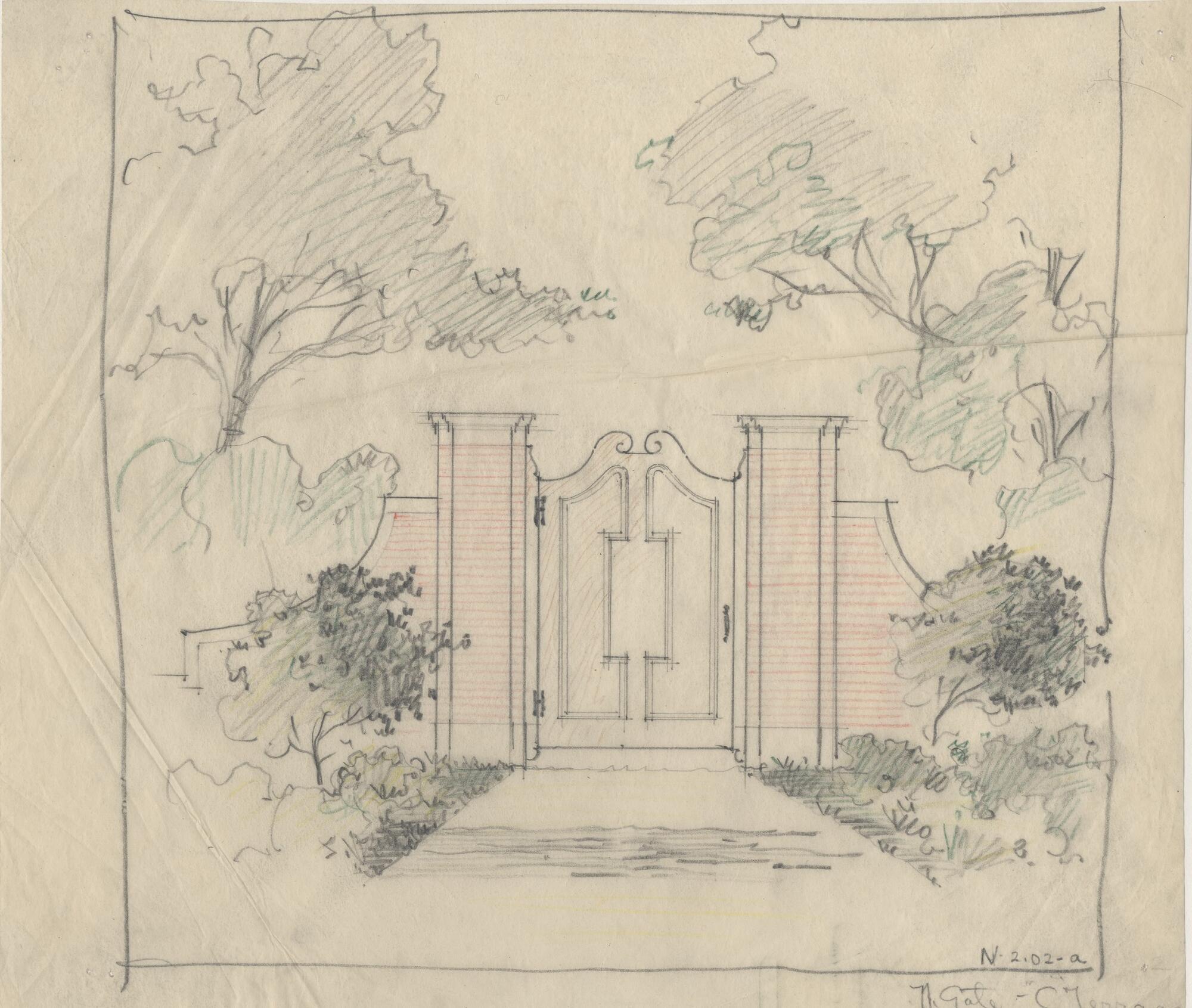
Farrand’s office also produced multiple full-scale drawings of details, especially concerning ornamentation. These drawings could be viewed in the office, on a table, or at the site held up in place. It was at this level of detail that Farrand made notes on the drawings to adjust and refine the design. As she was often working with stone masons, iron forgers, and furniture makers, she would assure that the full-scale design was exactly what she desired before sending it to be fabricated. This process of considering the design at full scale allowed her to assess the smallest of details as well as the ways the materials might shape the final product. It was an attention to detail that is easy to miss until production; however, it required extensive time not only in the production of the drawing but in the reviews and refinements.
Farrand’s planting designs were created first as a concept, then a drawing, and finally on-site for the final decisions. For the flower and herb beds, she frequently began with plans that appear similar in style to those by the esteemed British garden designer and writer Gertrude Jekyll. Plants were identified within irregular spaces, all merging together as a whole plan. Evergreens, larger shrubs, or trees were identified by specific shapes such as circles, triangles or squares. For larger gardens and landscapes, she frequently listed the plants to one side and placed corresponding numbers within the design next to each circle or irregular space identified as a plant. Rarely did she indicate the number of plants, nor did she seem concerned that they were marked exactly where they would be planted, as it would be decided at the time of planting depending on the individual specimens. This was the moment when a site visit was called for. The plants as they are grown in the garden attested to the ways in which Farrand both adhered to and refined her drawings. We can discover the translation of an idea into a work of art by walking the gardens with the drawings in hand.
Farrand’s furniture designs are another beautiful example of artifacts integral to the landscape and gardens. While many of these pieces have remained in place for almost a century, even the best-crafted wood furniture eventually ages until it no longer performs as intended. At Dumbarton Oaks we are privileged to have access to Farrand’s detailed drawings of the furniture and ornaments that pair with the actual pieces to comprise a richly detailed, living archive.
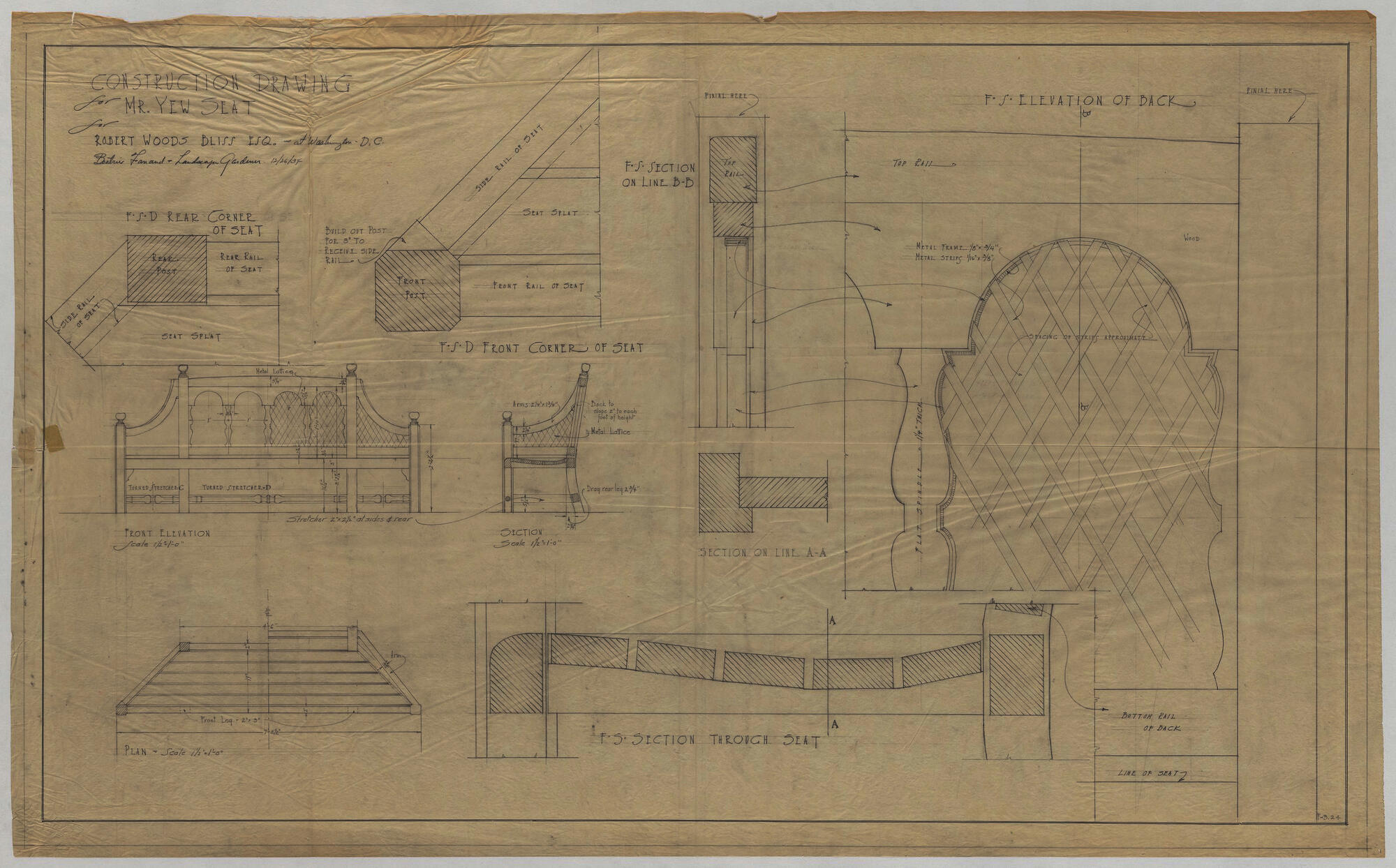
As a resource, the Garden Archives vividly documents how the Bliss garden and landscape designs developed, as well as the refinements considered and implemented over a century. This is a remarkable gift to all of us. However, the garden is also an archive in other ways. An important lens is the garden as ecological and horticultural archives that forefronts the physical artifacts of the landscape including plants, the water, the soil, and the ever-present natural systems and processes. The land on which Farrand designed the gardens is first a geological archive offering evidence of land formation and the power of water and rock to shape landscape. The site, with its ridge, valley, and stream had been used by indigenous communities for thousands of years. With the arrival of Europeans most significantly in the 18th century, the landscape was imagined and shaped by numerous families who sought to create a country place on the outskirts of the nation’s new capital in Washington, DC; these forces of change are all inscribed into the land.
Farrand was recognized for her deep horticultural understanding, and we continue to draw on that archival knowledge as we work with her gardens today. As is most clear in her notes for the Dumbarton Oaks Plant Book, she understood that as gardens were comprised of living materials that could not be frozen in time, and that her design would be most successful if the appropriate horticultural decisions were made as the garden matured. As she noted, “A garden is not a static object. … It must be constantly not only weeded and cared for, [but] … replanted from time to time in order, like the Red Queen in Alice, to stay in one place.”[5] Today in some of the garden rooms, we plant and tend to her specifications, including the wisteria on Arbor Terrace and the boxwood on Box Walk. In other garden rooms, appropriate replacements enhance her design intentions. Nevertheless, the gardeners pay close attention to the ecological health of each garden room, looking for signs of changing hydrology and new pests or diseases, as well as the more standard maturation of trees, shrubs, and vines, with an eye to replacing when they can. They also need to think about the challenges of invasive plants such as bamboo and English ivy, both of which are part of Farrand’s original design. This makes the garden a unique archive in that it can’t be simply catalogued and carefully stored away but must be constantly re-evaluated, curated, and actively tended every season, every year, every century. In this work curators draw from Farrand’s design intentions that made the space for gardening as an ever-changing and evolving activity.
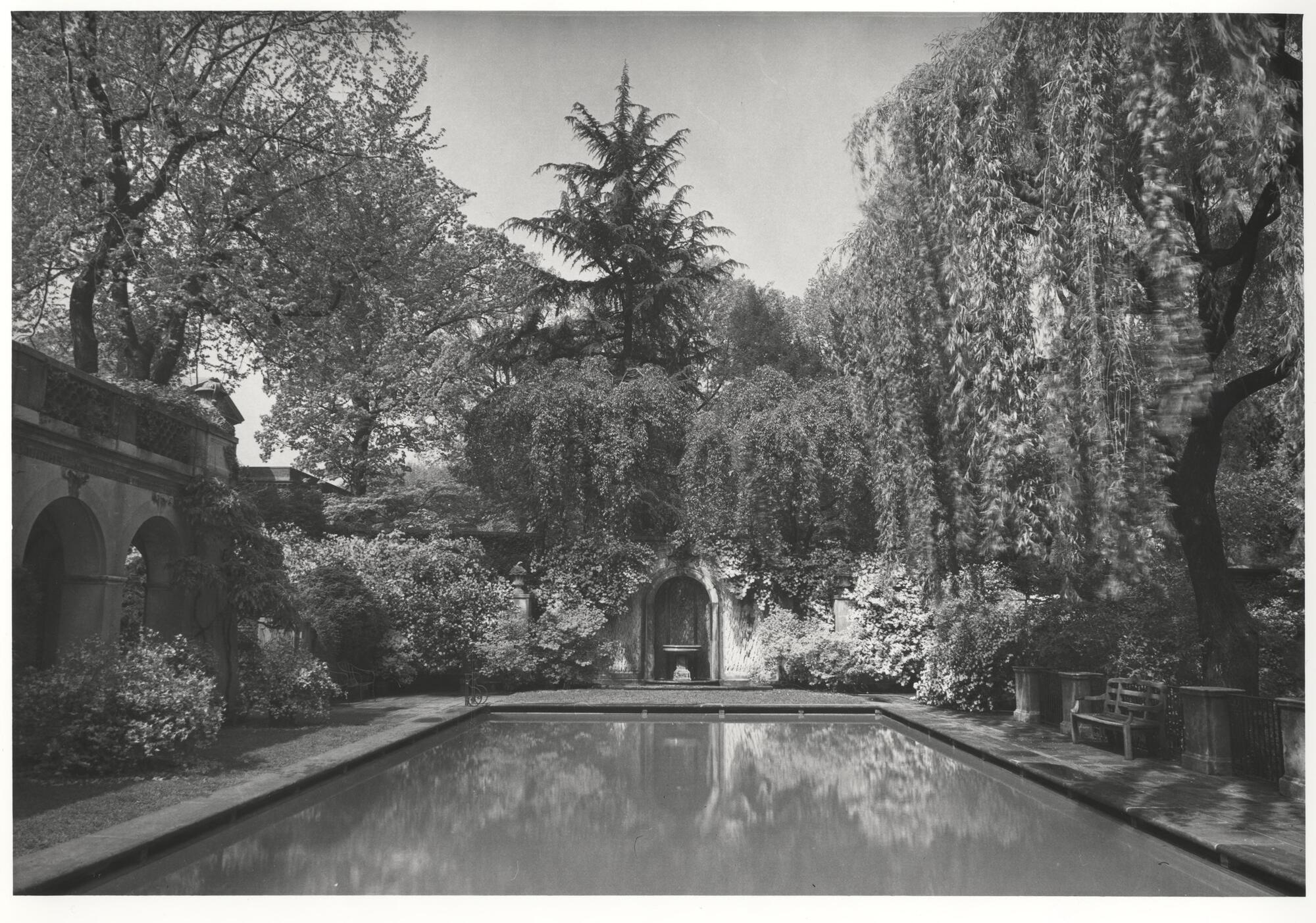
In establishing this remarkable place, Robert and Mildred Bliss wrote of their vision “to remember that Dumbarton Oaks is conceived in a new pattern, where quality and not number shall determine the choice of its scholars; that it is the home of the Humanities, not a mere aggregation of books and objects of art; that the house itself and the gardens have their educational importance and that all are of humanistic value.” Farrand realized the gardens and landscape , even a century later, remain a vital place of the humanities as a living work of art and a dynamic, rich archive.
Notes
[1] Beatrix Farrand to Mildred Bliss, June 24–25, 1922. Garden Archives, Dumbarton Oaks Research Library and Collection, Washington, DC. http://id.lib.harvard.edu/alma/99153723318403941/catalog
[2] Mildred Bliss to Beatrix Farrand, July 13, 1922. Garden Archives, Dumbarton Oaks Research Library and Collection, Washington, DC. http://id.lib.harvard.edu/alma/99153723318403941/catalog
[3] See, for example, Dianne Suzette Harris, and D. Fairchild Ruggles, eds., Sites Unseen: Landscape and Vision (Pittsburgh, PA: University of Pittsburgh Press, 2007); Rebecca Yamin and Karen Bescherer Metheny, Landscape Archaeology: Reading and Interpreting the American Historical Landscape (Knoxville: University of Tennessee Press, 1996); and Shadreck Chirikure and Munyaradzi Manyanga, Archives, Objects, Places and Landscapes: Multidisciplinary Approaches to Decolonised Zimbabwean Pasts (Langaa RPCIG, 2017), muse.jhu.edu/book/52180.
[4] Way, Thaïsa. Unbounded Practice : Women and Landscape Architecture in the Early Twentieth Century. Democracy and Urban Landscapes. Charlottesville: University of Virginia Press, 2009.
[5] Beatrix Farrand to John S. Thatcher, June 27, 1944. Beatrix Farrand File, Garden Archives, Dumbarton Oaks Research Library and Collection, Washington, D.C. https://www.doaks.org/library-archives/garden-archives/correspondence/le...
